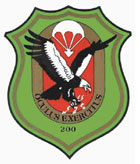Telephoto Watch Company 200
|
Fernspählehrkompanie 200 |
|
|---|---|
 Association badge |
|
| active | September 1, 1962 to 2015 |
| Country |
|
| Armed forces | armed forces |
| Armed forces |
|
| Branch of service | Army reconnaissance troops , initially long-distance reconnaissance troops |
| Strength | 210 men |
| Insinuation |
|
| last position | Pfullendorf |
| commander | |
| Last company commander | Captain Diana Herbstreuth |
The telephoto watch company 200 was the last remaining tele-spy company of the Bundeswehr . Most recently she was subordinate to the Rapid Forces division and stationed in the Staufer barracks in Pfullendorf , Sigmaringen district , Baden-Württemberg .
task
The company's task was to obtain information in the depths of the enemy space. In doing so, operationally important goals should be clarified, among other things to enable other forces to combat them. The company supported the Bundeswehr's special forces . The soldiers of the company were capable of stationary and mobile use day and night as well as of documenting and evaluating the information obtained through optronic special reconnaissance. The company's main task was to carry out military evacuation operations from crisis areas.
history
In November 1961, Major Konrad Rittmeyer began training the training staff. After ten months, the cadre was operational and on September 1, 1962, teaching group R was renamed Fernspähkompanie 200. The company was initially stationed in Altenstadt and was relocated to Weingarten in 1964 . Originally, each of the three corps of the German Army was assigned a televsion company. Accordingly, from October 1964 the telephoto watch company was subordinate to the II Corps .
Major Rittmeyer's successors as company commander were Major Winkler, Major Dieter Wendeborn and, from April 1, 1976 to December 31, 1978, Major Dieter Engel. On January 1, 1979, Captain Fritz Kobras took over the Fernspähkompanie 200.
On April 1, 1993, the company was renamed Fernspählehrkompanie 200. In 1993 soldiers from the company took part in the Bundeswehr's first foreign missions.
After the Bundeswehr reform in 1996, Fernspähkompanien 100 and 300 were dissolved. The telephoto watch company 200 was retained and in January 1997 was subordinated to the special operations training center in Pfullendorf (until 2003 still an international tele-spying school). This is where the company was based from the change of position until its dissolution. On July 1, 2006, the Telephoto Watch Company 200 was transferred to the Special Operations Division from the Special Operations Training Center.
On October 26, 2011, Federal Defense Minister Thomas de Maizière ( CDU ) presented the stationing concept 2011 in the federal cabinet , according to which the Fernspählehrkompanie 200 will be dissolved. The company was disbanded at the end of 2015 and its remaining parts were largely integrated into the airborne reconnaissance companies.
organization
The company's soldiers were part of the Army Reconnaissance Force . The nominal strength of the company was 226 men and it was divided into five platoons :
- Company command
- 4 Fernspäh trains divided into remote patrols
- 1 special tele-spy train
- 2 medical teams
- 1 field messages train
- 1 repair group
- 1 supply group
Most recently, the Fernspählehrkompanie 200 only consisted of a remote spying platoon as emergency services and was about 120 men strong.
Trains
The remote scouting trains included the scouting troops with four men each, which could be reinforced depending on the order. The long-distance spy train was split up among the long-distance spy trains according to order and requirement and supported by optical and optical special reconnaissance and in the pilot control procedure .
The train is divided into:
- Leadership squad
- Analysis and evaluation team
- Command support squad
- 2 remote patrols of 6 men each
equipment
To arm the company that included assault rifle G36K / AG36 , the submachine gun MP5 SD , the pistol P8 , the light machine gun G8 and the sniper rifle G22 .
See also
Individual evidence
- ↑ Army editorial staff: Vita company commander. In: Website of the Army . Federal Ministry of Defense , head of the press and information staff , August 27, 2014, accessed on December 22, 2014 .
- ^ The effects of the stationing concept in the state of Baden-Württemberg. Federal Ministry of Defense, October 26, 2011, archived from the original on October 26, 2011 ; Retrieved November 23, 2011 .
- ^ Army editorial staff: structure. In: Website of the Army . Federal Ministry of Defense , head of the press and information staff , March 13, 2014, accessed on September 2, 2014 .
- ↑ Christin-Désirée Rudolph : Eyes on Target - The televsioners of the Bundeswehr . Motorbuchverlag, Stuttgart 2008, ISBN 978-3-613-02852-4
Web links
Coordinates: 47 ° 54 ′ 36 ″ N , 9 ° 15 ′ 22 ″ E